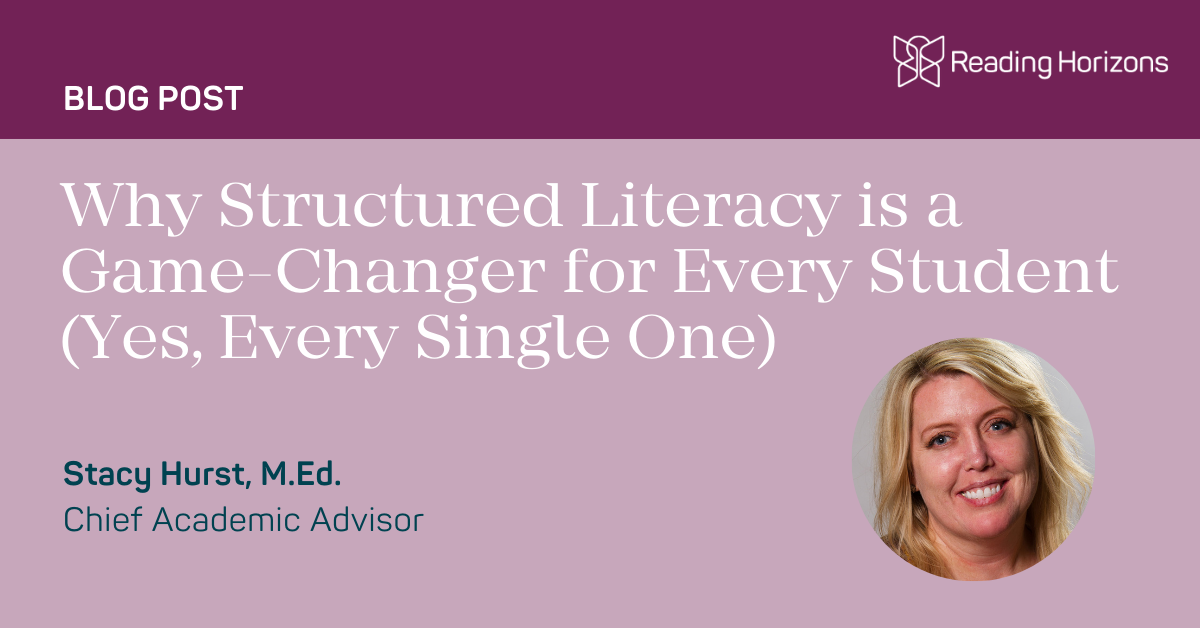(Yes, Every Single One)
By Stacy Hurst, M.Ed.
There’s a moment in every teacher’s career when reality slams into them like a freight train. It happens when you realize that despite your best efforts—despite pouring your heart into lesson planning and instruction—some of your students are still struggling to read. And not just a little bit. Their confidence crumbles, their frustration mounts, and their future suddenly feels uncertain.
That’s why I’m here to tell you, as plainly as I can: Structured Literacy isn’t just for some students—it’s for all students. And it’s the best shot we have at making sure every child becomes a proficient reader.
The Hidden Cost of Reading Failure
When we talk about the importance of Structured Literacy, we’re not just talking about test scores. We’re talking about real kids with real futures at stake.
As educators, we know that reading failure has ripple effects—on a child’s self-esteem, on their mental health, on their ability to access opportunities later in life. And as Lindsay Kemeny shared in our recent Literacy Talks podcast episode, this struggle is personal for many of us. Her son, diagnosed with dyslexia, also battled severe depression. The emotional toll of struggling to read can be devastating, and we need to stop treating literacy like an academic issue alone. This is a civil rights issue.
Children who struggle with reading are at a higher risk of disengaging from school and experiencing mental health challenges such as anxiety and depression. In his Plain Talk 2025 session, Dr. Tim Odegard referenced evidence from four longitudinal studies demonstrating that reading proficiency at age 7 has a significant impact on future mental health, influencing the likelihood of depression, attention difficulties, and anxiety at ages 9 and 11 (McArthur et al., 2022). Too often, students’ potential is limited before they even have the opportunity to discover what they are truly capable of achieving.
Structured Literacy changes that trajectory.
What Makes Structured Literacy Different?
A lot of people ask, “What makes Structured Literacy different from other approaches?” The simple answer is that Structured Literacy is rooted in the Science of Reading, effectively integrating instructional content with fundamental teaching principles.
- Science-Based Approach
- Unlike Whole Language and some Balanced Literacy approaches, Structured Literacy is grounded in decades of cognitive science research on how the brain learns to read.
- It directly addresses the needs of all learners, especially those with dyslexia and other reading difficulties.
- Explicit & Systematic Instruction
- Structured Literacy does not assume children will infer phonics patterns through exposure. Instead, it teaches phonemic awareness, phonics, morphology, syntax, and semantics in a structured and direct manner.
- Other approaches, such as Balanced Literacy, rely more on implicit learning strategies and contextual guessing.
- Cumulative & Mastery-Based Learning
- Structured Literacy follows a logical progression, ensuring that students master foundational skills (e.g., phonics, decoding) before moving to more advanced reading and comprehension skills.
- Whole Language and Balanced Literacy may introduce complex texts before students have a firm grasp of decoding.
- Multimodal & Diagnostic Approach
- Structured Literacy incorporates multimodal techniques (visual, auditory, kinesthetic) to reinforce learning.
- It also monitors student progress continuously, allowing teachers to adjust instruction based on individual needs—something often lacking in more immersive, context-driven approaches.
- Emphasis on Decoding & Encoding
- Structured Literacy teaches students how to break words down (decoding) and construct words (encoding/spelling) systematically.
- Balanced Literacy often emphasizes recognizing words through context clues rather than decoding skills.
Unlike methods that rely on memorization or guessing strategies, Structured Literacy ensures that every student—especially those who struggle—gets what they need to build a strong foundation.
The Research is Clear—So Why Aren’t We All Doing This?
One of the most frustrating things about Structured Literacy is that we already know it works. The research has been replicated over and over. There is overwhelming evidence that direct, systematic, and explicit instruction is the most effective way to teach reading.
So why isn’t it universal?
Well, for starters, teacher prep programs haven’t historically provided this training. Many of us—myself included—had to learn about Structured Literacy on our own, often long after we’d already been in the classroom.
And then there’s the myth that Structured Literacy is “too rigid” or “one-size-fits-all.” That couldn’t be further from the truth. A strong Structured Literacy framework actually gives teachers more flexibility to adjust instruction based on student needs. It provides a roadmap, but it also allows us to make the right turns when needed.
If we don’t have a structured approach, we’re leaving kids’ reading success up to chance. And we can’t afford to do that.
Every Student Deserves a Teacher Who Knows How to Teach Reading
One of my biggest takeaways from this conversation with Lindsay and Donnell is that teaching reading isn’t just about having a good curriculum—it’s about having well-trained teachers.
Programs don’t teach kids to read. Teachers do.
That means we need professional development. We need ongoing support. We need to make sure every teacher, from pre-service to veteran, has the knowledge and confidence to teach reading in a way that actually works.
Because the truth is, every student—regardless of background, ability, or learning differences—deserves to be a reader.
If you’re reading this and thinking, “I need more support with this,” you’re not alone. That’s exactly why we created the Science of Reading Collective—to give educators like you a place to learn, grow, and share best practices.
Let’s stop leaving reading success to chance. Let’s make Structured Literacy the standard—not the exception.
Because every child deserves the chance to read well.
Join the Conversation
What’s been your experience with structured literacy? Have you seen the impact firsthand? Let’s keep this conversation going in the Science of Reading Collective and on social media.

